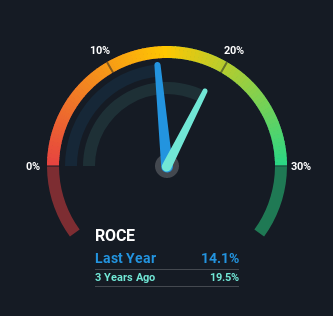Kansai Nerolac Paints (NSE:KANSAINER) Could Be Struggling To Allocate Capital

If we want to find a stock that could multiply over the long term, what are the underlying trends we should look for? Amongst other things, we'll want to see two things; firstly, a growing return on capital employed (ROCE) and secondly, an expansion in the company's amount of capital employed. If you see this, it typically means it's a company with a great business model and plenty of profitable reinvestment opportunities. However, after briefly looking over the numbers, we don't think Kansai Nerolac Paints (NSE:KANSAINER) has the makings of a multi-bagger going forward, but let's have a look at why that may be.
What is Return On Capital Employed (ROCE)?
For those that aren't sure what ROCE is, it measures the amount of pre-tax profits a company can generate from the capital employed in its business. The formula for this calculation on Kansai Nerolac Paints is:
Return on Capital Employed = Earnings Before Interest and Tax (EBIT) ÷ (Total Assets - Current Liabilities)
0.14 = ₹6.0b ÷ (₹57b - ₹14b) (Based on the trailing twelve months to December 2021).
Thus, Kansai Nerolac Paints has an ROCE of 14%. In absolute terms, that's a pretty standard return but compared to the Chemicals industry average it falls behind.
Check out our latest analysis for Kansai Nerolac Paints

Above you can see how the current ROCE for Kansai Nerolac Paints compares to its prior returns on capital, but there's only so much you can tell from the past. If you'd like to see what analysts are forecasting going forward, you should check out our free report for Kansai Nerolac Paints.
So How Is Kansai Nerolac Paints' ROCE Trending?
When we looked at the ROCE trend at Kansai Nerolac Paints, we didn't gain much confidence. Over the last five years, returns on capital have decreased to 14% from 23% five years ago. Although, given both revenue and the amount of assets employed in the business have increased, it could suggest the company is investing in growth, and the extra capital has led to a short-term reduction in ROCE. And if the increased capital generates additional returns, the business, and thus shareholders, will benefit in the long run.
Our Take On Kansai Nerolac Paints' ROCE
Even though returns on capital have fallen in the short term, we find it promising that revenue and capital employed have both increased for Kansai Nerolac Paints. In light of this, the stock has only gained 35% over the last five years. So this stock may still be an appealing investment opportunity, if other fundamentals prove to be sound.
One more thing, we've spotted 2 warning signs facing Kansai Nerolac Paints that you might find interesting.
While Kansai Nerolac Paints may not currently earn the highest returns, we've compiled a list of companies that currently earn more than 25% return on equity. Check out this free list here.
If you're looking to trade Kansai Nerolac Paints, open an account with the lowest-cost platform trusted by professionals, Interactive Brokers.
With clients in over 200 countries and territories, and access to 160 markets, IBKR lets you trade stocks, options, futures, forex, bonds and funds from a single integrated account.
Enjoy no hidden fees, no account minimums, and FX conversion rates as low as 0.03%, far better than what most brokers offer.
Sponsored ContentValuation is complex, but we're here to simplify it.
Discover if Kansai Nerolac Paints might be undervalued or overvalued with our detailed analysis, featuring fair value estimates, potential risks, dividends, insider trades, and its financial condition.
Access Free AnalysisHave feedback on this article? Concerned about the content? Get in touch with us directly. Alternatively, email editorial-team (at) simplywallst.com.
This article by Simply Wall St is general in nature. We provide commentary based on historical data and analyst forecasts only using an unbiased methodology and our articles are not intended to be financial advice. It does not constitute a recommendation to buy or sell any stock, and does not take account of your objectives, or your financial situation. We aim to bring you long-term focused analysis driven by fundamental data. Note that our analysis may not factor in the latest price-sensitive company announcements or qualitative material. Simply Wall St has no position in any stocks mentioned.
About NSEI:KANSAINER
Kansai Nerolac Paints
Manufactures and supplies paints and varnishes, enamels, and lacquers in India.
Excellent balance sheet average dividend payer.
Similar Companies
Market Insights
Community Narratives



